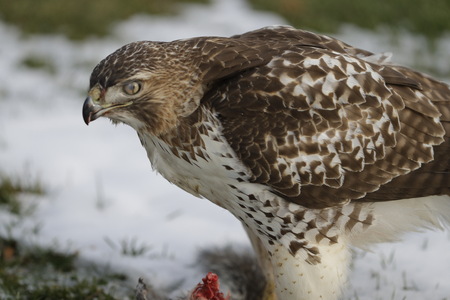
Good Natured: Nictitating Membranes A.KA. Third Eyelids
Maybe you can relate.
At home and at work, I have an overabundance of protective eyewear—a.k.a. safety glasses or goggles. Some are squirreled away in drawers and cabinets at Casa Otto while others are in the glove box and in the Good Natured Mobile Unit. Then there's the pair I wear when riding my motorcycle, and the spares in each of my motorcycle jackets. I also keep safety glasses with the chainsaw and reciprocating saw and, for some unknown reason, at the back of the spice cabinet in the kitchen.
But you know what? I still get stuff in my eyes. Why? Because it seems those safety glasses are never quite where I need them, when I need them.
If only I had nictitating membranes.
These fantastic now-you-see-'em, now-you-don't adaptations are present in many different classes in the animal world, perhaps most famously in birds but also in many fish, amphibians and reptiles, as well as most mammals. Yet notably absent from this list of creatures with built-in eye protection are some members of our very own taxonomic order: the primates. More on this later.
First though, let's explore the structure itself.
The word nictitate means to wink, and it comes from the older (and easier to pronounce) verb nictate, which means the same thing. Both words can be traced back to nictare, the Latin word for winking.
But unlike standard winking, or blinking (but not nodding), which involves the outer eyelids, use of the nictitating membranes does not produce a momentary loss of vision. In most animals, the typically clear tissue passes horizontally across the eyeball, starting at the inner, or medial, corner of the eye and proceeds outward, moistening, cleansing and protecting along the way.
You might have noticed these functions are very similar to that of the outer eyelids. For this reason plus, and I can't mention this enough, the fact that nictitating membrane is hard to say, the anatomical term often is replaced by the more user-friendly name, third eyelid. (Some references also cite the word haw as a synonym, but since I can't say haw without inserting a hee before it, for now we'll pass on that one.)
If you see an American toad excavating a burrow, or a painted turtle paddling down toward the depths of a pond or river, and wonder how they can get mud in their eyes without suffering any damage…the answer is third eyelids.
If you've ever marveled at how a woodpecker can jackhammer a new home in a tree without going blind from the splinters, or how a peregrine falcon can dive at speeds up to 240 mph and not lose sight of its prey…the answer is third eyelids.
If you've admired how a beaver can see whilst paddling underwater, or how a polar bear doesn't go snow blind even when surrounded by miles of bright white…give credit to third eyelids—which also can function as built-in sunglasses.
Beavers and polars bears, however, are among an elite group of mammals that have full-on nictitating membranes. But not all critters are so lucky.
In dogs and cats, the third eyelid usually stays out of sight. Still, if you're lucky enough to have a furry roommates, you might catch a glimpse of it when your Fido or Fluffy is sleeping with their eyes slightly open. The look of that opaque tissue where you're used to seeing a bright iris and pupil is freaky for sure, but usually no cause for alarm, unless it doesn't retract upon waking. (That's when you set your nature reading down, and call your vet.)
Then there's us humans. Highly evolved creatures that we are, we have what are known as the plica semilunaris, the half-moon fold. Or, in simpler terms, the vestigial third eyelid.
When it comes to eyes, human or otherwise, I'm pretty squeamish, and perhaps you are too. But if you can stand to look at one of your eyes in a mirror, peer closely at the inner corner. The innermost pink tissue is the lacrimal caruncle, and the thin fold of bulbar conjunctiva, or mucous membrane, right next to it is what is left of our third eyelid.
No one's really sure why we, and chimpanzees, have lost our fully functioning third eyelids, but the change is thought to stem from changes in habitat and eye physiology over time. But even though it's vestigial, which means it no longer serves its original purpose, it helps us with tear drainage and eye movement, so it's still handy to have.
The next time you're out observing wildlife, keep your eyes open for animals using their safety goggles. Zoom in on a Cooper's hawk plucking a dove, or a crow feasting on discarded French fries. But be quick about it! Those nictitating membranes disappear…in the blink of an eye…
Pam Otto is the outreach ambassador for the St. Charles Park District. She can be reached at potto@stcparks.org.

